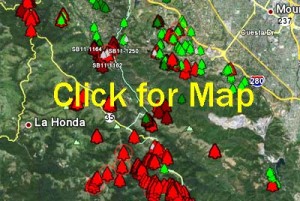Question:
My organization is considering launching a large-scale urban tree planting project in the Bay Area, with the goal of adding one million trees to the urban forest inventory within 15 years. We are interested in coast live oak (CLO) as a major component of the effort for a number of reasons, including the ease with which seed can be collected and planted, drought tolerance, habitat value, high potential for carbon sequestration and rainfall interception, and status as a “signature tree” of the local landscape.
The plan is to gather seed locally from many locations, and plant with minimal site preparation and no supplemental irrigation or other artificial life support systems. Trees will be monitored and cared for over time, and replanting will take place as needed to ensure that we continue to make progress toward our goal. Obviously we don’t want to exacerbate the sudden oak death problem. Our hope is that, on the contrary, widespread and large-scale planting with subsequent monitoring might help identify resistant trees. What recommendations do you have?
Answer:
First of all, this is a really neat project and you are absolutely correct about the benefits of planting CLO. Based on the information provided, the following are recommendations for the project:
In addition to coast live oak, it would also be good to plant Oregon white oak in the northern greater Bay Area, valley oak in the middle portion of the Bay Area, and blue oak in the southern part of the Bay Area. The rationale for this is that diversity/biodiversity is always good and the three alternate oak species are immune to SOD. A good overall planting ratio would be 75% CLO and 25% other species.
The big issue is going to be when California bay laurel is present, as it helps to spread Phytophthora ramorum. CLO should never be planted within 20-25 yards of bay for this reason. Unfortunately, bay has become invasive and SOD is actually increasing its abundance, so where bay is at least 10% of the stand, plant the other oak species recommended above. In riparian areas, bay should be left untouched.









